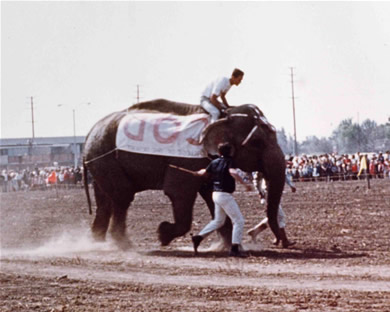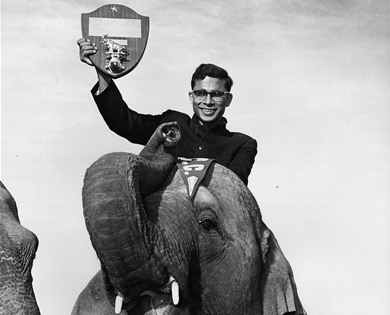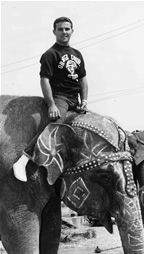Campus Remembers 1962 Elephant Race
During the 50th anniversary kick-off weekend, Cal State Fullerton will once again see elephants racing — just not real ones as there were in 1962. On Saturday, Sept. 15, three contests will be held beginning at 1 p.m.: one in which 18-inch electronic elephants charge to the finish line, another with three-wheeled, human-powered “elephants” and finally, a contest for children using “stick” elephants.
In 2000, several of the original elephant riders, or mahouts, returned to campus to reminisce about the historic event. This is an article written about that event from the May 1,2000 issue of the faculty-staff publication.
September 11, 2007
A century before a certain fledgling campus was paired with its mascot, American poet John Godfrey Saxe was inspired by an Indian fable to describe the response of six blind men who are placed before different parts of an elephant.
One man pats its “broad and sturdy side” and proclaims that the animal is very much like a wall. Another fingers its tusk and likens the animal to a spear. And so it goes: the squirming trunk … a snake; the floppy ear … a fan; the swinging tail … a rope; and the knee … a tree.
As with all good parables, this one speaks to us today. While fully sighted, several men who were there seem to have experienced quite differently the genesis of “The First Intercollegiate Elephant Race in Human History.”

Harvard University's entry took the sweepstakes award in a competition marred by only one major glitch: a one-eyed behemoth scattered the crowd when it veered —without incident — off course. More than 10,000 spectators, including camera crews aloft in helicopters, witnessed the festivities, which were televised to Canada and radioed to Kuwait. At year’s end, Associated Press ranked the story as one of the year’s top ten.
But whose bright idea was “The First Intercollegiate Elephant Race in Human History” anyway? And was it a joke turned serious?
We offer you the opportunity to troll for the truth hidden in these narratives.
Mary A. Koehler, writing in “Kaleidoscope 1959-84”: “(The elephants races) came about after activity advisers — tired of explaining rules on a case by case basis —made up a form groups could use when organizing. For illustrative purposes, opposite ‘Name,’ a hypothetical “Elephant Racing Club” (ERC) was inserted.
“Intrigued, several students sought and got permission to form such an organization. Sure that since no one would respond it could claim victory by default, the ERC then invited nearly 100 colleges across the nation to enter elephants in a race supposedly scheduled for May 11, 1962. To ERC’s chagrin, several takers replied; now trapped, it had to proceed.”

Emmett “Shorty” Long, a university founder and emeritus professor of speech communication: “Ernie Becker, who had taught in India, thought we should do something to celebrate the Day of the Titan. So, at a meeting with students, he said, ‘How about an elephant race?’ The students took him seriously, but he was joking. Within a day I heard about it, but I thought no way was it going to take place. Becker originally didn’t take the idea seriously, but then it got out of control and took off on its own.”
Raynolds Johnson, emeritus professor of communications and the public relations director at the time of the race: “Assistant Dean Ludwig Spolyar thought it was a good idea to form a men’s service club, so he got together with Ben Wade, a student, to organize it. Dean Becker, who had lived in India, suggested they call it the Elephant Racing Club. The three of them decided to hold races and got approval from Dr. William B. Langsdorf (the campus’ founding president).
“They called me in and we planned the race at a series of strategy meetings and sent out invitations. I think the administrators were the driving force behind the race at first. There was no doubt that there would be a race. Most of the members of the student body thought we were blowing smoke until they saw that the race was really going to take place.”
Ben Wade, then a student majoring in social science education: “Dean Becker delegated to Ludwig Spolyar the responsibility of creating a model constitution. As an example of a club’s name, Spolyar wrote in the name of the Elephant Racing Club. For a laugh, he showed the model to a group of us students drinking coffee in the patio. We started kicking around the idea of actually starting an Elephant Racing Club.
“I said college kids will join just about anything. We set dues at 50 cents and collected $30. The Day of the Titan was upcoming, so we decided to challenge prestigious institutions to race our elephant. We figured we’d rent an elephant for the day as a tourist attraction, and charge for rides and pictures to pay for the $100 rental fee. And when no other elephants showed up, we’d crown ourselves the champions.
“A few weeks after the invitations went out, the L.A. Times ran a picture of two Coast Guardsmen with an elephant they claimed to be training for the race. Dean Becker showed me the picture and said, “What are you going to do about this?” Four of us drove to Jungleland and rented an elephant. And even though the Coast Guard picture was a public relations hoax on their part, the race was on because it stimulated interest at other universities and the idea of the race gained more and more momentum. Dean Becker was dragged into it kicking and screaming, but he became a convert in the end when we convinced him the race would put our little college on the map.”
* All of these observers agree, though, that whatever its genesis, the actual elephant race was one of the giddy triumphs of their life.
And if the gentle reader gains neither historical insight nor entertainment from this exercise, then let him or her at least leave these commentaries with a question to ponder, dwelling as we do in an orchard turned Grove of Academe.
To honor the memory of Dr. Becker, a professor of philosophy, we conclude with the final lines of the poet Saxe’s “The Blind Men and the Elephant,” which had its own inspiration in the sayings of Siddhartha, the Buddha:
“So, oft in theologic wars
The disputants, I ween
Rail on in utter ignorance
Of what each other mean
And prate about an elephant
Not one of them has seen!”

Capt. Hook and its mahout (rider) Remesh Mehra were winners for Orange
Coast College in the First Intercollegiate Race in Human History
held on campus on May 11, 1962


